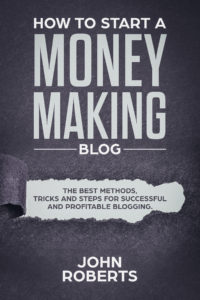Monetize your Site or Blog with Adsense
There are lots of ways to make money with your site or blog but one of the easiest is to monetize your blog with paid advertising such as Adsense
Today we want to walk you through how to monetize a blog using Adsense.
AdSense
As mentioned in the previous parts of the book, AdSense is Google’s ads publishing service for websites, YouTube videos, and apps. This advertising platform is one of the easiest to implement. To add it to your website, all you have to do is to follow these steps:

Register your website with AdSense advertising
The first challenge for using AdSense is getting your application approved. It is common for a website to have their application for access declined for various reasons. One of the most common reasons is the presence of banned content in your website.
AdSense cannot be used in websites that discuss topics like pornography, gambling or any other illegal activities. Even mentioning the word Baccarat once in your blog could trigger the anti-gambling flag of the registration process.
Fortunately, AdSense will show you the content in your website that prevented your registration from being approved. You will need to clean up your websites of all the mentioned content and resubmit it for reconsideration.
There are a lot of other reasons that a website’s application is declined. It is also common for websites with low-quality content to be declined. If your web posts or pages only have a few sentences each, your application may also not go through. Just to make sure that your content is not flagged, make sure that each one contains at least 300 words.
Aside from these factors, the website’s age may also be considered by the registration algorithm. If the blog is just a few days old, the AdSense team generally questions the commitment of the webmaster to stick with the project. This may lead them to halt the registration process until the website is at least a couple of weeks old and already has some content.
[How to Start a Money Making Blog: The Best Methods, Tricks and Steps for Successful and Profitable Blogging.]
If this is the reason cited for your failure to register an account, then the best option is to keep creating content to populate your website. When AdSense detects that there is a steady increase of clean content for your website, it may allow you to post ads.
Create an ad or link ad unit in AdSense
After registration, the next step is to create ad units. By creating ad units, you will be able to name ads and adjust their appearance as they look in your website. Naming ads is important because the name will allow you to check which ad units are particularly effective in getting clicks.
You will have multiple options for ads in AdSense. You can create a simple banner ad. These banner ads have fixed sizes and are usually not suited for users using mobile phones. If your blog gets a lot of visits from mobile phone users, it may be best to use a responsive ad unit instead. Responsive ads adjust the size and shape of the ad container depending on the size of the screen of the users.
blog gets a lot of visits from mobile phone users, it may be best to use a responsive ad unit instead. Responsive ads adjust the size and shape of the ad container depending on the size of the screen of the users.
Aside from the above-mentioned ad formats, you can also create a link ad. Link ads differ from the two because they do not contain images. Instead, it only contains text links where in a list of topics is listed.
Native ad units are newer types of ads for AdSense publishers. This type of ad is also responsive. The key feature of this type of ad is that it is supposed to look like a part of your regular content. In the process of creating an ad unit, you will be asked to adjust the appearance of the ad. You will choose where the image of the ad will be shown. You may also modify the location and the color of the text in the ad.
The idea is to adjust these factors so that it looks like the ad is also a part of your content.
Copy the code of the ad unit and paste in your desired location in your website
After creating an ad unit, AdSense will show you a code that you will need to add the ad unit to your websites. To add ads to your website, you simply need to copy the code and paste it in the area where you want it to show.
The process on how to do this depends on the website management software that you are using. For WordPress users, for example, a number a plugin exists to help you insert your ads automatically into your website. You could make use of these plugins or you could add the ads manually.
Check if your ads are running
After creating your ad unit, it usually takes a few hours for it to be populated with the right kind of ads. If your account is new and your website has not been checked yet by the AdSense team, you may see some filler ads in the area where you placed the code.
After two to three hours, you should see ads already showing up in your chosen areas. The content of the ads are chosen based on an auction system. The advertisers set a maximum amount for bidding for ad places.
Every time a user requests a page with Google ads, the algorithm does an automatic auction for the ad spots in the page. The advertiser with the highest bid wins the spot. Their advertisement is shown in the spots where the codes are located.
Because of its simplicity and the popularity of Google ads, AdSense is one of the most used ads publishing service online. Almost all major news websites use AdSense. Because they are so common, AdSense has a reputation of having low click-through rates.
Now that we are discussing advertising, let us discuss some concepts that you may find useful when running ads to your business. Namely, let’s talk about impressions, clicks, cost-per-click and click-through rates.
Important Terms and Concepts in Advertising
Impressions
Impressions refer to the accumulated number of times that visitors in your website load an ad on their screen. Let’s say you have three ads in your post, one at the topmost part of your page (before the header), one within the content/article and one after the content.
When the page loads, the visitor only sees the topmost part of the web page. This imaginary line that divides the upper part of the page from the lower part is called ‘the fold’. Everything above the fold is automatically seen by the visitor when the page loads.
Because one of your ads is located above the headers, we can safely assume that it is above the fold. Since the other two ads are in the content and after the content. They may be located below the fold.
An impression is only triggered when the visitor scrolls to the part where the ad is located. Once the page loads, all ads above the fold automatically ticks and adds to your impression count.
When the person scrolls down and reads the content, the other ads below the fold trigger an impression count. You will see the number of impressions for each ad unit in your AdSense Dashboard.

Clicks and Cost-per-click
As the name suggests, clicks refer to the number of times a visitor clicks on an ad in your webpage. Clicking an ad redirects the visitor to the advertiser’s landing page. Most ads in the AdWords network pay via a cost-per-click system. That means that the advertiser only pays you when your visitors click on their ads.
Because you are only paid when ads are clicked, it is logical to think that your goals are basically to increase the number of clicks on the ads on your website. However, AdSense has strict rules in preventing fraudulent clicks.
From the AdSense point of view, a click is only valid if a person does it in his or her own choosing without being influenced by the content of the webpage to do so. Ideally, the person should really be interested in the advertising for the advertising network to be effective. However, this factor depends on the content of the ad and is beyond your control as the ad publisher.
Click-through rates
The click-through rates refer to the percentage of the time that visitors click on ads in your web pages compared to the total number of impressions. Let’s say that you’ve shown a total of 1000 ads during an entire day to visitors. This is the total number of impressions for your website in the given timeline.
If 10 people clicked on ads, for example, you can get the click-through rates by dividing the number of clicks by the total number of impressions. This means that your click-through rate for that day is 0.01 or 1%.
It is common for AdSense publishers to have click-through rates south of 1%. This means that 99% of the ads viewed on the webpage has little to no value because they did not generate revenue for the blogger of the website owner. Because of this, most small time blogs choose to also find other means of monetizing their websites aside from their AdSense ads.
Let us know if you have any questions in the comments below.



